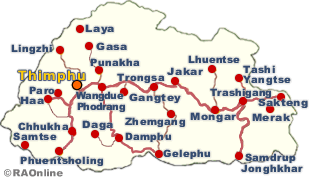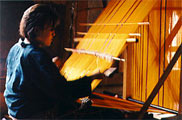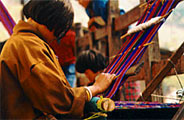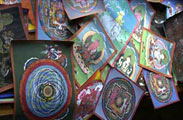|
Punakha
celebrated its first three-day tshechu in the dzong following the annual
goempoe Drupchen which concluded on February 17, 2005 with the norbu
chusani (symbolic
immersion of the Rangjung Khasarpani in the Mochu) ceremony.
|
There
is a reason why Chhume in Bumthang is famous for its yathra (woolens) weaves. It is the main marketing outlet for about 240 households of 13
villages in Bumthang who depend on the sale of yathra for their livelihood.
People
from Zhungri, the farthest village, about a day"s walk to Chhume, sell
their products to the dealers in Chhume once a month. "They prefer exchanging
their yathras for groceries and garments," said Yeshey, a yathra dealer
in Chhume. |
|
Gayden,
35, from Chhume Nangar said that having a yathra weaver in the family
meant being able to bring home all the daily necessities. She allowed her
daughter and two nieces to drop schools and take up yathra weaving. "A
family that has more women weaving is looked up with pride and considered
a well to do family," said Gayden.
In
winter, the yathra dealers in Chhume also provide temporary employment
to school students. At the most they employ about 10 students to weave.
The dealers provide three meals a day to the students and pay them
between Nu 160 to Nu 340 depending on the quality of the weave. Simple
weaves that take a few days earn Nu 160 and weaves with more intricate
patterns that take about a week are paid Nu 340.
A
number of families in Chhume have pulled out their daughters from schools
and made them take up weaving. Even the women teachers and employees in
various departments, and those working at the road sides in Chhume are
learning to first turn the wool into threads and then weave. "If you learn
to weave you can save your money for something bigger," said a woman from
Chhume Nangar. "We can barter our products for our basic needs."
Yeshey
said that he gives money to people who take money for their yathras and
groceries for those who want to barter their products. "Although I sometimes
face problems of not being able to pay for the yathras I take all they
bring," he said.
Each
year Yeshey supplies about 100 to 200 yathra pieces to the various textile
shops in Thimphu. He sells them for Nu 600 to Nu 1,800 depending on the
quality of the product. According to Yeshey, the products he buys or exchanges
with the villagers fetches him about Nu 20,000 to Nu 30,000 during the
tourist seasons and drops down to Nu 5,000 to Nu 6,000 during the lean
tourist seasons. "Besides being a tourist attraction, we are trying to
preserve our country"s textile art," Yeshey said.
The
more authentic yarn (wool) used for weaving the yathra is usually
brought from Swiss although most prefer using the wool from India. "Bhutanese
wool is considered to be of greater quality," said Yeshey. "But the charges
are abnormally high."

|
This
article was contributed by KUENSEL, Bhutan's National Newspaper |

|







